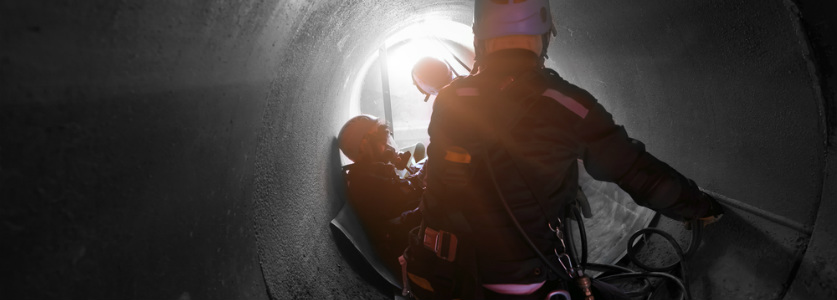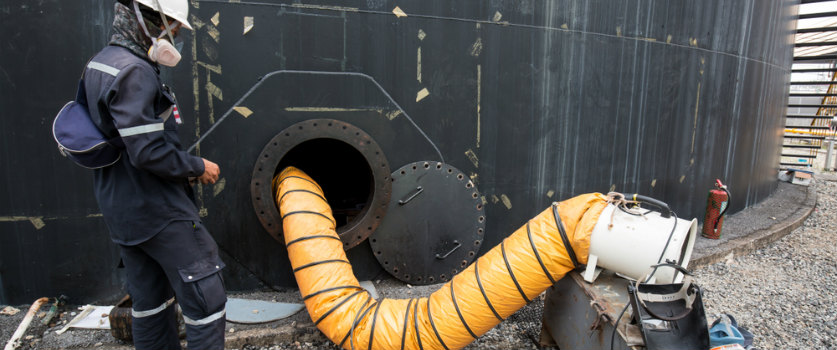Nitrogen Gas Safety Precautions – Is Nitrogen Dangerous?
October 08, 2019
The use of gaseous nitrogen has become almost indispensable in numerous industrial manufacturing and transport processes. The inert nature of this gaseous element makes it ideal for use in processes where process–driver side reactions may cause alterations to the final products.

While the uses of gaseous nitrogen are countless, it must be handled in accordance with industrial safety regulations. Nitrogen should be treated as a potential safety hazard regardless of the scale of the industrial process in which it is being employed.
This article will outline various safety concerns that arise with the industrial use of nitrogen gas and vital precautions needed to avoid occupational accidents.
Is Nitrogen Dangerous?
High concentrations of nitrogen gas can be particularly harmful to human health. Nitrogen can displace oxygen from ambient air within an enclosed space leading to a dangerous build-up of the inert gas.
Is Nitrogen Gas Dangerous?
Inhaling air containing mostly nitrogen will lead to various signs of physical and mental impairment. Depending on the concentration of nitrogen a person is exposed to, signs and symptoms from sudden unconsciousness to death due to asphyxiation could occur.
Nitrogen Safety Concerns
One of the properties of nitrogen gas which makes it particularly dangerous is its physical property of being odorless. In the absence of nitrogen detecting devices, the risk of industrial workers being exposed to a dangerous nitrogen concentration is significantly higher.
The probability of systems operating on nitrogen developing undetected leaks is a major safety regulatory concern which various occupational health preventive guidelines attempt to address.
Nitrogen Gas Safety Precautions
Various countries have different safety regulations guiding the use of nitrogen for industrial purposes. In the United States, OSHA (Occupational Safety and Health Administration) tasks industrial manufacturers to maintain a safe working environment for employees. For example, OSHA 29 CFR 1910.146 sets guidelines for confined spaces that could contain higher than normal concentrations of nitrogen gas.
Regardless of industrial location, it is vital that all production process managers conduct nitrogen gas risk assessment exercises to determine their level of exposure, and institute adequate preventive measures. Also, all personnel must be trained on the proper use of personal protective devices as well as proper actions to carry out in case of accidental hazardous exposure. Outlined below are effective industrial precautions for improved nitrogen gas safety.
Early Warning Mechanisms
OSHA nitrogen gas regulations require industrial employers to identify and properly label areas of high or potentially high concentrations of nitrogen gas with clearly visible warning signs. In addition to posting bold signs warning workers of potential risks of enclosed spaces, employers will need to obtain special permits for confined spaces containing hazardous nitrogenous materials.
Continuous Atmospheric Monitoring
Mandatory testing for confined industrial spaces is required for all employers in accordance with OSHA guidelines. Sampling atmospheric air within these spaces will help to determine its suitability for breathing. Tests to be carried out on the sampling air include:
- Oxygen concentrations
- Combustible gas presence
- Tests for toxic vapors
Further, regardless of the duration of stay, OSHA requires all employers to provide an attendant just outside a permit-required space whenever personnel are working within it. This person is required to constantly monitor the gaseous conditions within the space and call for rescuers if the worker inside the confined space becomes unresponsive.
It is vital to note that at no time should the attendant attempt to enter the hazardous space to conduct a rescue unassisted.

Adequately Ventilated Spaces
Forced draft air circulation in restricted areas will significantly reduce the build-up of noxious gases and limit the chances of a fatal exposure. While this strategy can be used in areas with low nitrogen leak risks, workers are prohibited from entering pure nitrogen gas environments without using appropriate respiratory equipment. In these cases, personnel must use appropriate artificially supplied air equipment.
Implementation of Rescue Training Protocols
Due to the odorless nature of nitrogen gas, attempts by an employee to rescue an unconscious co-worker from a confined space might lead to compounding the problem. This will occur due to the failure of the rescuer to identify the level of hazardous nitrogen gas exposure within the restricted area.
A key aspect of ensuring nitrogen asphyxiation safety is by properly training all personnel involved in industrial nitrogen manufacturing processes. Core components of this training should include:
- Proper use of personal protective devices by rescuers
- Use of body harnesses and lifelines connected to rescue team members
- Emphasis on non-entry rescue in single personnel scenarios
- Training on nitrogen cylinder safety
GENERON Can Help with Your Nitrogen Gas Needs
For forty years, GENERON has remained committed to providing its customers with a full complement of highly effective process equipment specifically designed for applications in various industrial manufacturing sectors.
For more information about how GENERON Nitrogen Generation Systems can help meet your needs, please contact us online today!
